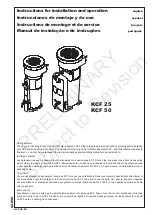
Single compressors
Operating conditions
High and low pressure
protection
High pressure
Low pressure
Crankcase heating function
Electronic expansion valve
Pressure settings
According to EN378-2, a high-pressure (HP)
safety switch is required to shut down the
compressor. The high-pressure switch can be set
to lower values depending on the application
and ambient conditions. The HP switch must
either be placed in a lockout circuit or consist of
a manual reset device to prevent cycling around
the high-pressure limit. If a discharge valve is
used, the HP switch must be connected to the
service valve gauge port, which must not be
isolated. The HP switch can be connected to the
CDS803 input 27 or an external contactor placed
between the drive and the compressor. When put
the contactor before the drive, note that drive
will continue to run for a while even the power
is off, and this will lead to extend compressor
running time at high pressure stage which could
be dangerous.
Thus, it is recommended to place the contactor
between the drive and the compressor.
Please note port 27 is not UL certificated and
when connected with high pressure switch, no
delay is permitted. OEM need to set port 27 to
“coast reverse/coast and reset inverse” to get rid
of minimum running time restriction.
A low-pressure (LP) safety switch must be
used. Deep vacuum operations of a scroll
compressor can cause internal electrical arcing
and scroll instability. VZH compressors exhibit
high volumetric efficiency and may draw very
low vacuum levels, which could induce such
a problem. The minimum low-pressure safety
switch (loss-of-charge safety switch) setting is
given in the following table. For systems without
pump-down, the LP safety switch must either be
a manual lockout device or an automatic switch
wired into an electrical lockout circuit. The LP
switch tolerance must not allow for vacuum
operations of the compressor. LP switch settings
for pump-down cycles with automatic reset are
also listed in the table below. The lock-out circuit
or LP switch or series with other safety devices
could be connected to CDS803 input 27. The low
pressure switch must have the highest priority
that shall not be by passed. It means when
low pressure switch is activated, compressor
minimum running time should not work. OEM
need to set port 27 to “coast reverse/coast and
reset inverse” to get rid of minimum running time
restriction.
There is no crankcase heating function in
CDS803. An external crankcase heater is
required, and surface sump heater type should
be preferred. Refer to accessory list for code
numbers.
With variable capacity systems, an electronic
expansion valve (EXV) is the strongly
recommended solution to handle refrigerant
mass flow variations. Danfoss recommends the
use of ETS products. Ramp-up and ramp-down
settings, of both EXV and compressor, must be
done with great care.
Ramp-up of the EXV must be shorter than
the ramp-up of the compressor, to avoid any
low pressure operation on suction side of the
compressor. The EXV can also be opened, up
to a certain degree, before the start up of the
compressor.
Ramp-down of the EXV must be longer than the
ramp-down of the compressor, also to avoid low
pressure operation (except with pump-down).
EXV should be closed, and remain closed,
when the compressor is off, to avoid any liquid
refrigerant entering the compressor.
Pressure settings
R410A
Working pressure range high side
bar (g)
8.3 - 41.1 bar
Working pressure range low side
bar (g)
1.5-13.9 bar
Maximum high pressure safety switch setting
bar (g)
43.75
Minimum low pressure safety switch setting *
bar (g)
1.0
Minimum low pressure pump-down switch setting **
bar (g)
1.18
* LP safety switch shall never be bypassed.
** Recommended pump-down switch settings: 2.2 bar below nominal evaporating temperature with minimum of 1.18
28
FRCC.PC.034.A2.02
Application Guidelines
















































